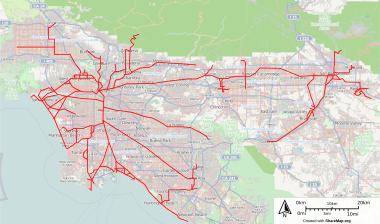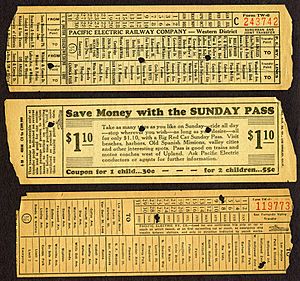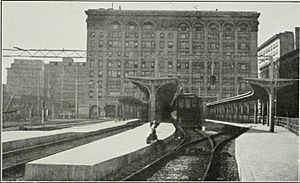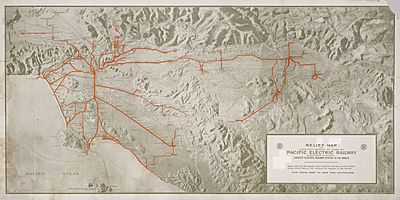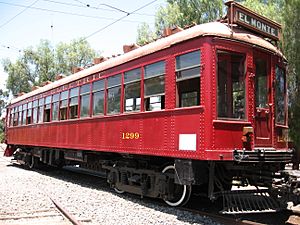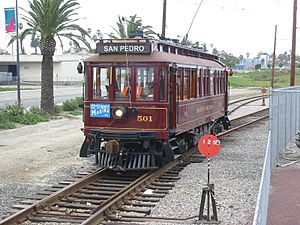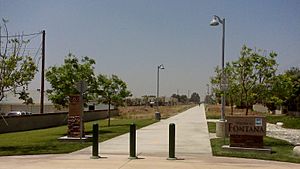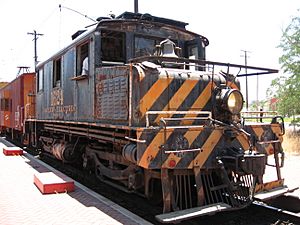Pacific Electric facts for kids
The Pacific Electric Railway Company, often called the Red Cars, was a huge public transportation system in Southern California. It used electric trains, streetcars, and buses. In the 1920s, it was the largest electric railway system in the world!
The Red Cars connected many cities across Los Angeles, Orange, San Bernardino, and Riverside counties. It was like a giant spiderweb of tracks and roads. The system even shared some tracks in downtown Los Angeles with another railway, the "Yellow Car" system.
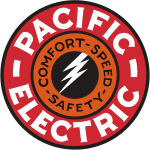 |
|

Main depot, circa 1910
|
|
| Overview | |
|---|---|
| Headquarters | Los Angeles, California |
| Reporting mark | PE |
| Locale | Greater Los Angeles Area |
| Dates of operation | 1901–1961 (passenger), 1965 (freight) |
| Successor | Southern Pacific (freight) Los Angeles Metropolitan Transit Authority, Los Angeles Metro Rail (passenger) |
| Technical | |
| Track gauge | 4 ft 8 1⁄2 in (1,435 mm) standard gauge |
| Electrification | 600 V DC overhead line 1200 V DC overhead line (San Bernardino Line only) |
Contents
Where the Red Cars Traveled
The Pacific Electric system was divided into four main areas:
- Northern District: This area covered the San Gabriel Valley. It included cities like Pasadena, Alhambra, El Monte, and Monrovia.
- Eastern District: This district reached into the Inland Empire. Cities here included Pomona, San Bernardino, Riverside, and Redlands.
- Southern District: This part of the system connected to coastal cities. You could ride to Long Beach, Newport Beach, Huntington Beach, and San Pedro.
- Western District: This area served famous places like Hollywood, Beverly Hills, and the San Fernando Valley. It also went to beaches like Santa Monica and Redondo Beach.
How the Red Cars Started
Early Days of Electric Trains
Electric streetcars first appeared in Los Angeles in 1887. In 1895, the Pasadena & Pacific Railway was formed. Its goal was to boost tourism in Southern California, with the motto "from the mountains to the sea."
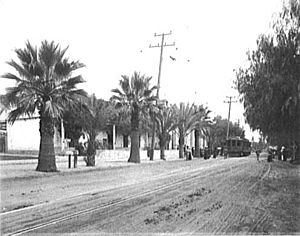
The Pacific Electric Railway was officially created in 1901. It was founded by a railroad leader named Henry E. Huntington and a banker named Isaias W. Hellman. Huntington had experience with electric trolley lines in San Francisco. He wanted to connect Los Angeles with nearby cities using new electric rail lines.
Hellman and his investors owned most of the company. They started buying land and planning routes. The very first major line, connecting Los Angeles to Long Beach, opened on July 4, 1902.
The company sometimes faced disagreements with its workers, which led to strikes. These issues continued for many years, especially around World War I.
More Than Just Trains
For the investors, the real money wasn't just from selling train tickets. It came from supplying electricity to new communities and buying and selling land. Local groups would offer Huntington land deals to get the railways and electricity to their towns. Soon, Huntington and his partners owned a lot of land in places like Naples, Huntington Beach, and Newport Beach.
Another powerful railroad owner, E. H. Harriman of the Southern Pacific Railroad, was worried about the competition from these new electric lines. He tried to buy into Huntington's company, but Huntington refused. Eventually, after some business battles, Huntington and Harriman became equal partners in the Pacific Electric in 1903. This deal allowed Huntington to keep expanding the PE, but he agreed not to compete with Harriman's existing train lines.
Building the Network
In 1903, Huntington created another company, the Los Angeles Inter-Urban Railway. He planned to extend lines to many more cities, including Santa Ana, Newport Beach, and the San Fernando Valley. He also created the Los Angeles Land Company to help with real estate.
By 1905, lines to Newport and Santa Ana were finished. By 1910, the Pacific Electric operated almost 900 miles of track! The routes reached areas that were just starting to grow.
Huntington saw the railway as a way to help his real estate projects. Harriman, however, saw it as part of the Southern Pacific's larger transportation system. In 1910, Huntington sold his share of the Pacific Electric to Southern Pacific. In return, he gained full control of the Los Angeles Railway, known as the "Yellow Cars."
The "New" Pacific Electric
On September 1, 1911, the Southern Pacific created a new Pacific Electric Railway Company. All electric train operations were now under the Pacific Electric name. This was called the "Great Merger."
After this, PE became the largest electric railway passenger service in the world. It had over 1,000 miles of track and ran 2,160 trains every day! It served many places in Southern California, especially to the south and east.
The Southern Pacific also started focusing more on freight (carrying goods) with the PE. Freight revenue grew a lot during this time.
In the 1920s, the Red Cars were very popular. They extended lines to Pasadena, the beaches, and other areas. Extra trains ran on weekends, especially when people wanted to return home from the beaches. The Red Cars even had special "Railway Post Office" routes to deliver mail, which was unusual for electric trains.
The PE also invented an important safety device for railroad crossings: the automatic electromechanical grade crossing signal, nicknamed the "wigwag." This device quickly became popular with other railroads.
Why the Red Cars Disappeared
The Rise of Cars
Huntington used the Red Cars to help sell his land. But by 1920, most of his land had been developed. Many of the train lines in rural areas didn't make much money. The company made up for these losses with money from busy passenger lines and freight.
As more people bought cars, fewer rode the Red Cars. The least-used Red Car lines were replaced with cheaper bus routes as early as 1925.
Much of the PE track in cities was on streets shared with cars and trucks. As car traffic grew, the Red Cars became slower. For example, the Santa Monica Boulevard line, which connected Los Angeles to Hollywood and Santa Monica, only averaged 13 miles per hour.
By the late 1930s, traffic was a big problem. The Automobile Club of Southern California suggested building freeways and replacing streetcars with buses. City planners even thought about putting train tracks in the middle of freeways, but this rarely happened.
Many lines were cut in the late 1930s and early 1940s. When the San Bernardino Freeway opened in 1941, it caused even more traffic jams in downtown Los Angeles. This made it harder for the Red Cars to keep their schedules, and more people chose to drive.
World War II and Beyond
During World War II, the Red Cars carried many more passengers. Los Angeles County's population grew a lot because of war industries. For a few years, the company made a profit because gasoline and rubber were rationed, and people relied on public transport. However, the trains were old and needed repairs.
After the war, local governments decided to build a huge network of freeways. They thought this was a better solution than upgrading the Red Car system.
In 1953, the remaining PE passenger service was sold to Metropolitan Coach Lines. This company was known for buying streetcar systems and replacing them with buses.
Many more lines closed in the 1950s. The famous Hollywood Boulevard and Beverly Hills lines closed in 1954. Service to the San Fernando Valley, Burbank, and Glendale ended in 1955.
Government Takes Over
In 1958, the California state government took over the remaining and most popular lines from Metropolitan Coach Lines. They also bought the "Yellow Car" lines. The government agency, called the Los Angeles Metropolitan Transit Authority (MTA), started running all the lines as one system.
The Los Angeles-to-Long Beach passenger rail line was the last to operate, from 1902 until April 9, 1961. It was the first and last interurban passenger line of the Pacific Electric system.
The very last streetcar routes, the "Yellow Cars," were removed in early 1963. The public transportation system continued to operate under the Los Angeles MTA until it became the Southern California Rapid Transit District in 1964.
The PE's freight service continued until 1965, using diesel trains on the old PE tracks. Today, the Union Pacific Railroad still uses some of the former PE tracks for freight.
What Happened Next
New Trains for Los Angeles
In the 1970s, people started talking seriously about needing more public transportation. This was due to environmental concerns, a growing population, and the 1973 oil crisis. There were also discussions about how companies like Pacific City Lines might have helped shut down streetcar systems across the U.S., including in Los Angeles. The movie Who Framed Roger Rabbit even has a story loosely based on these ideas.
In 1976, California formed the Los Angeles County Transportation Commission (LACTC) to plan new transportation systems. Construction on new rail lines began in 1985. In 1993, the LACTC and another agency merged to form the Los Angeles County Metropolitan Transportation Authority (LACMTA).
In 1990, electric passenger train service returned to Los Angeles when the Metro Blue Line opened. It used much of the old PE tracks from downtown Los Angeles to Long Beach. Since then, the LACMTA has opened more lines:
- The Metro Red Line subway opened in parts between 1993 and 2000. It connects Union Station to Hollywood and the San Fernando Valley.
- The Metro Green Line opened in 1995. It runs in the middle of the Century Freeway.
- The Metro Gold Line opened in 2003, connecting downtown Los Angeles to Pasadena. It uses tracks that once belonged to the Santa Fe Railroad.
Metrolink (Southern California) also provides high-speed train service for commuters in Los Angeles and surrounding counties.
The Waterfront Red Car was a special streetcar line in San Pedro. It used newly built Red Car replicas and a restored old Pacific Electric car for tourists. It operated from 2003 to 2015.
The Expo Line, a light rail line, opened in 2012, connecting downtown Los Angeles to Culver City. It was extended to Santa Monica in 2016.
Future Plans
More rail lines are being planned and built.
- A new light rail line is being designed to connect San Bernardino with the University of Redlands by 2021. It will be the first line in the country with a zero-emission, battery-operated passenger train.
- The Gold Line is planned to extend further east to Montclair, possibly even to Ontario International Airport.
- The Purple Line (formerly part of the Red Line) is being extended west along Wilshire Boulevard to Westwood. Construction began in 2014.
- There are also plans for new passenger rail lines on old railway corridors, like the Harbor Subdivision, connecting Carson to downtown Los Angeles.
- The West Santa Ana Branch Transit Corridor project aims to build a new light rail line to Artesia.
The Red Car's Lasting Impact
The Pacific Electric Railway left a big mark on Southern California.
- The Pacific Electric Trail is a 21-mile long walking and biking path built along the old San Bernardino Line.
- The Red Car Trolley at Disney California Adventure Park is a fun attraction based on the PE. It uses two trains that look like the old Red Cars.
- The main station building at Knott's Berry Farm theme park is actually an old PE train depot from Stanton, California, moved there in 1952.
- Some people say the red color of the trains on the Keikyu Railway in Tokyo was inspired by the Red Cars.
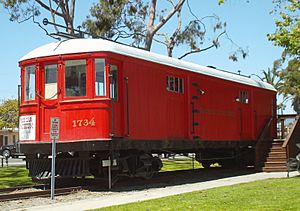
Red Car Routes
|
Northern Division:
|
Western Division:
|
Southern Division:
|
Red Car Facilities
The Pacific Electric system used 600-volt direct current power, delivered through overhead lines. The San Bernardino Line also used 1200 volts DC in some parts.
Some important locations for the Red Cars included:
- West Hollywood Car Barn and Yard
- Ocean Park Car Barn and Yard
- Torrance Shops
- Pacific Electric Building (the main station at 6th & Main)
- Subway Terminal Building (another station at 4th and Hill St.)
- Belmont Tunnel (the Hollywood Subway)
- Substation No. 8
- Substation No. 14
- Redlands Trolley Barn
Red Car Fleet
Passenger Cars
| Manufacturer | Model | Started Service | Fleet Series | Quantity | Retired Year | Notes | Image |
|---|---|---|---|---|---|---|---|
| St. Louis | "Baby Five" | 1902 | 200–229 500–529 |
30 | 1934 | First cars built for Pacific Electric. Car 524 is at a museum. | |
| St. Louis | "Medium Five" | 1909 | 230–249 530–549 |
20 | 1934 | Car 530 is at a museum. |  |
| 250– | |||||||
| "Big Five" | 1911 | 550–599 | 50 | Acquired from Los Angeles Pacific Railroad | |||
| J. G. Brill | Birney | 1918 | 320–339 | 20 | 1941 | ||
| 1920 | 340–388 | 49 | |||||
| c. 1906 | 400– |  |
|||||
| Pacific Electric | motor car | 1904 | 600–602 | 3 | Rebuilt from old San Francisco cars | ||
| express car | c. 1904 | 6 | |||||
| trailer | c. 1904 | 6 | |||||
| St. Louis | Hollywood car | 1922 | 600–649 | 50 | 1949 | Most cars rebuilt into 5050 series interurban cars | |
| 1924 | 650–699 | 50 | |||||
| J. G. Brill | 1924 | 700–749 | 50 |  |
|||
| St. Louis | 1928 | 750–759 | 10 | ||||
| American | interurban | 800– | |||||
| Jewett | "Business Car" | 1912 | 1000 | 1 | 1947 | Upgraded from a regular car in 1913 |  |
| MU interurban | 1912 | 1001– | 1954 |  |
|||
| Standard Steel | interurban car | 1100– | From Hammond, Indiana | ||||
| Pressed Steel | Steel Cars | 1915 | 1200–1224 | 25 |  |
||
| Pullman | Portland MU interurban | 1912 | 1252 | ||||
| Pullman | "Business Car" | 1929 | 1299 | 1 | Built in 1912, rebuilt for PE |  |
|
| Pullman-Standard | PCC | 1940 | 5000–5029 | 30 | 1955 | Sold to a railway in Argentina in 1958 | |
| Pacific Electric | 1949 | 5050– | 1951–1958 | Rebuilt from Hollywood cars. Some sold, some kept for Los Angeles transit. Five are at a museum. |  |
||
| St. Louis | MU coach | 1907 | 1950 | ||||
| St. Louis | Blimp MU | 1930 | 1959 | ||||
| Pullman | Blimp MU coach | 1913 | 61 | 1961 | |||
| Pullman | Blimp MU baggage coach | 1913 | 1959 | ||||
| American | trailer coach | 1908 | 1934 | ||||
| Pullman | officer's car | 1912 | 1958 | ||||
| J.G. Brill | Portland RPO-baggage | 1913 | 1959 | ||||
| St. Louis | double-truck Birney | 1925 | 1941 | ||||
| Pullman | Submarine | 1912 | 1928 |
Work Cars
- LAP trolley wire greaser (1898–1957)
- PE tower car (1915–1957)
Locomotives
- 1600 class electric locomotives
Freight Cars
- LA&R flat-top caboose (1896)
- PE flat-top caboose PE (1939)
- LS&MS caboose (1915)
- LV caboose (1926)
- RF&P caboose (1905)
- SSC box car (1924)
Buses
- GM yellow coach
See also
 In Spanish: Pacific Electric para niños
In Spanish: Pacific Electric para niños


